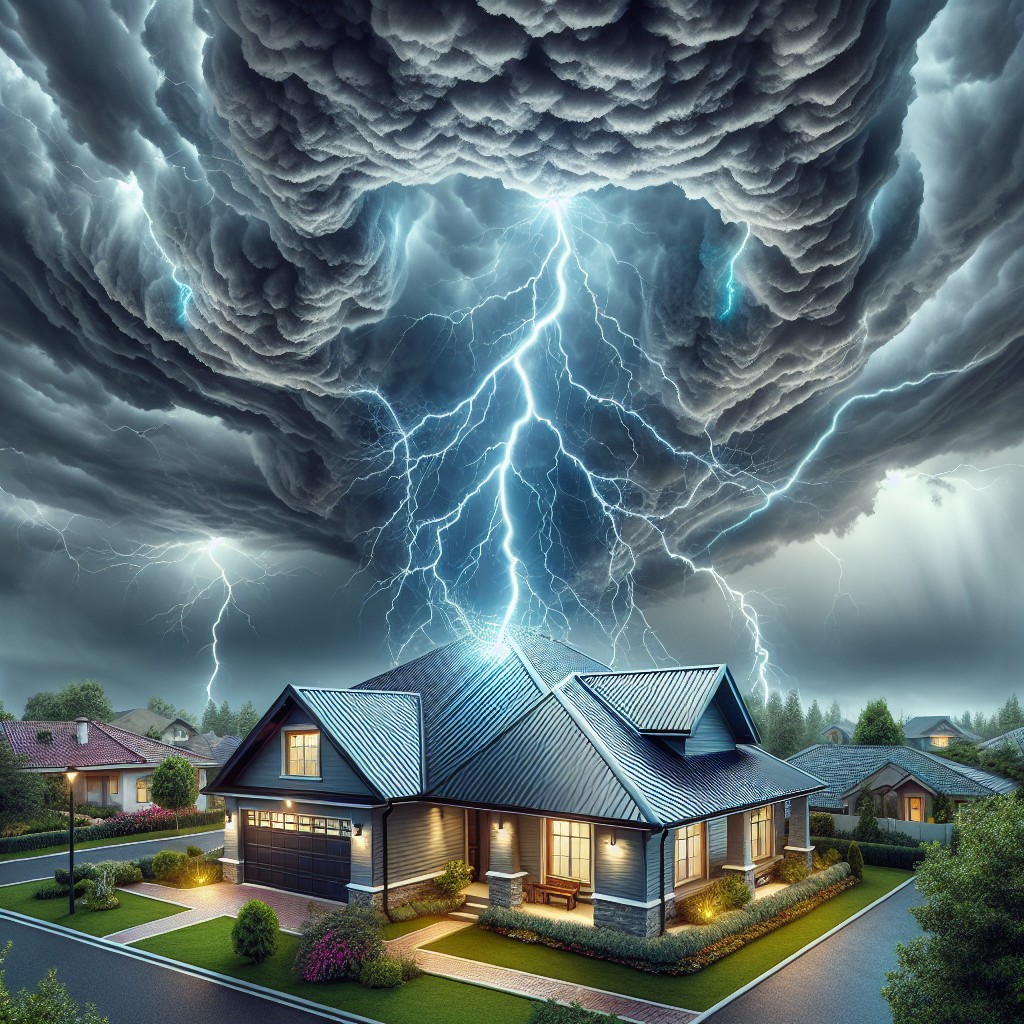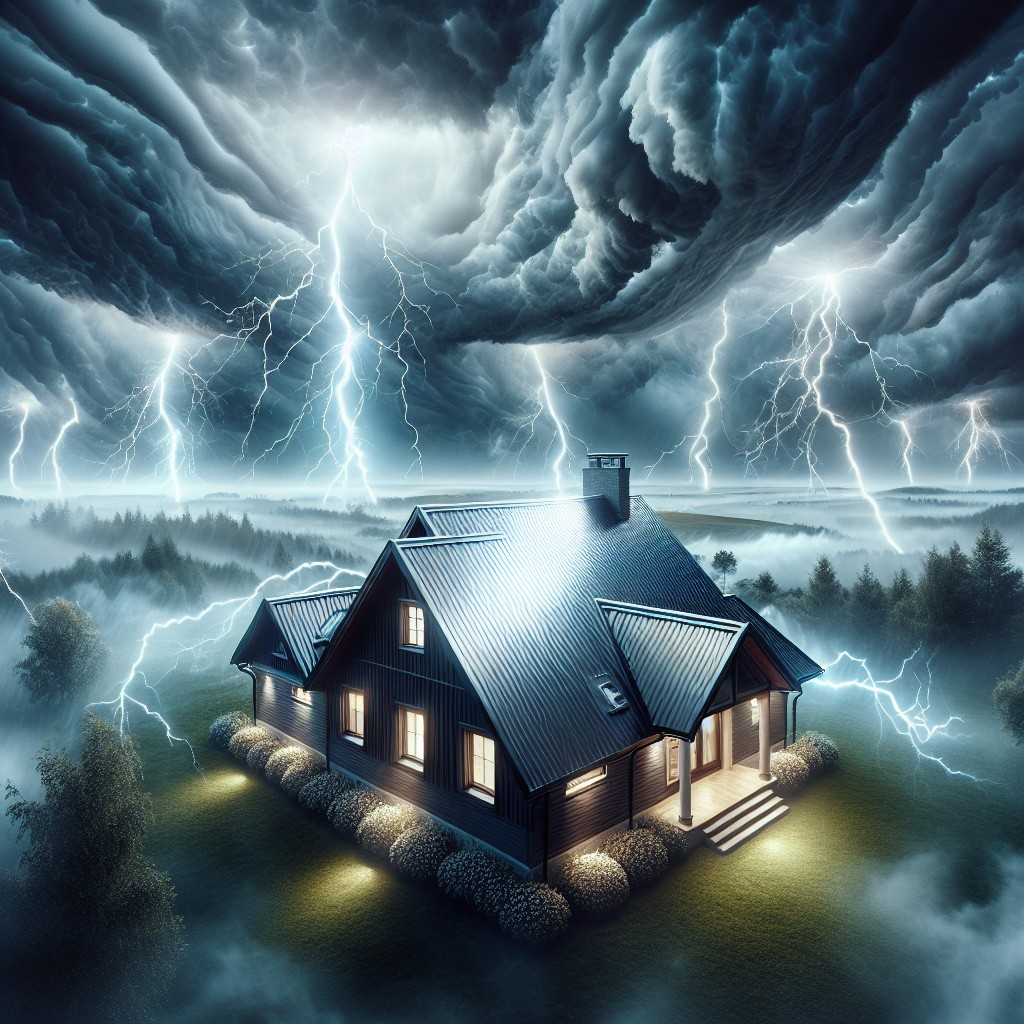Last updated on
Although metal conducts electricity, metal roofs do not attract lightning any more than other types of roofing materials because lightning is primarily attracted to the highest objects in an area, regardless of the material they are made of.
Dispelling myths with science, this article tackles the common misconception that metal roofs are magnetic beacons during thunderstorms. As residents nestle beneath the roofs over their heads, questions about their material choices and the safety implications during electrical storms often arise.
By engaging with evidence-based explanations, readers will learn that the material of their roof isn’t the lightning magnet they might have thought. Instead, the geographical traits of their abode, along with its height and dimensions, play a more significant role in lightning’s complex dance toward Earth.
For those considering metal roofing or looking to quell their stormy weather concerns, this piece illuminates how conductivity and proper grounding, rather than material attraction, define lightning strike risks.
Key takeaways:
- Metal roofs do not attract lightning more than other roofing materials.
- Lightning strikes are determined by the height, size, and location of structures.
- Metal conducts electricity but does not draw lightning to it.
- The path of least resistance to the ground determines where lightning will strike.
- Proper grounding and lightning protection systems can enhance safety.
The Science of Lightning

Lightning is a powerful electrical discharge resulting from atmospheric conditions, chiefly the presence of storm clouds, also known as cumulonimbus clouds. Here’s a brief explanation of its formation:
- Static Electricity: The thunderstorm creates an environment ripe for lightning due to the turbulent mixing of particles within the clouds, resulting in electrical charges.
- Polarization: As the charges within the cloud separate, with positive charges accumulating at the top and negative at the bottom, an electric field is created. The strength of this electric field is what makes the air a good conductor of electricity.
- Step Leaders and Streamers: When the electric field becomes strong enough, a stepped leader descends from the cloud, seeking a path of least resistance. In response, streamers (positive charges) rise from the ground or objects on the ground. When a leader and streamer connect, the circuit is completed, and a lightning strike occurs.
- Transfer of Charge: The visible flash of lightning is the current as it travels, moving electrons from the cloud to the ground, neutralizing the difference in charge.
Understanding these fundamental principles helps explain why or why not certain objects, like metal roofs, might affect the behavior of lightning during a thunderstorm.
Lightning Facts

Lightning is a natural electrical discharge caused by imbalances between storm clouds and the ground or within the clouds themselves. These imbalances are rectified through a rapid release of energy in the form of a lightning bolt, which can heat the air it passes through to temperatures five times hotter than the sun’s surface.
Most lightning strikes occur either at the beginning or end of a storm. The average lightning strike carries an electric current of about 30,000 amperes, and the voltage can be 100 million to a billion volts. Despite its power, a lightning bolt is only about one to two inches wide.
The duration of a lightning strike is short, typically around 30 microseconds. Lightning’s immense power and heat can cause significant damage to structures, trees, and electronics, and it can be fatal to living organisms. It is estimated that the Earth is struck by lightning approximately 100 times per second, leading to nearly 8 million strikes per day worldwide.
Lightning does not solely occur in thunderstorms; it can happen in volcanic eruptions, extremely intense forest fires, surface nuclear detonations, heavy snowstorms, and even in large hurricanes. However, the majority of lightning occurs in the warm season, when the atmosphere is most conducive to the development of strong thunderstorms.
Are Metal Roofs Hit More Often?
Metal roofs do not inherently attract lightning more than other roofing materials. The prevalence of lightning strikes on structures has more to do with their height, size, and location than the materials from which they are made. A metal roof is just as likely to be struck by lightning as a roof made from other non-metallic materials if the structures are of similar size and at the same location.
Lightning is an electrical discharge between the atmosphere and an earthly object. It often targets the tallest object, which can provide a pathway to the ground. This could include trees, poles, or buildings. The material of the object is secondary to its height and geographical setting.
Moreover, while metal conducts electricity, it does not draw lightning to it. The main factor that determines where lightning will strike is the path of least resistance to the ground, not the material composition of structures. Thus, regardless of roofing material, a building that is isolated, tall, and situated on higher ground is more at risk of being struck than a shorter building surrounded by taller structures.
It’s also important to note that the large surface area of metal roofs does not influence the likelihood of a strike. The focus should be on minimizing potential damage and ensuring safety through proper grounding and the installation of lightning rods where necessary.
What Influences The Path Of The Lightning?
Lightning follows the path of least resistance to reach the ground. Several factors affect its route, including:
- Height – Taller structures are more likely to be struck because they are closer to the charged cloud base.
- Pointed Shape – Sharp points on a structure can concentrate electrical charge, making it a more attractive path.
- Isolation – Solitary buildings or trees are more likely to be hit as they provide a direct route for lightning’s path to the earth.
- Conductivity – Materials that conduct electricity well, such as metals, offer less resistance, potentially guiding lightning towards them.
- Moisture Content – Wet materials, including trees and soil, are better conductors of electricity, which can make them more susceptible to strikes.
- Surrounding Topography – High ground, such as hills and ridges, are more prone to lightning strikes than lower lying areas.
These elements, rather than the material composition of your roof, predominantly determine the likelihood of a lightning strike.
Metal Roofs and Lightning: The Truth
The prevalent myth that metal roofs attract lightning is rooted in a misunderstanding of how lightning behaves. Indeed, metal conducts electricity; however, lightning is not drawn to metal roofs any more than other materials. Lightning strikes are determined by a variety of factors, primarily the tallest object in a given area, as well as topography and atmospheric conditions.
In the rare event that a metal roof is struck by lightning, it is actually less likely to catch fire compared to other roofing materials, thanks to the non-combustible nature of metal. Moreover, metal’s high conductivity disperses the electrical charge over a larger area, reducing the impact of the strike.
Nevertheless, to further enhance safety, homeowners can invest in a lightning protection system. Such a system includes air terminals and conductors that provide a low-resistance path for lightning to follow, safely guiding the electricity into the ground without damaging the structure.
In summary, metal roofs do not lure lightning more than any other roofing material. The safety and durability of metal roofs, coupled with a properly installed lightning protection system, can provide homeowners with peace of mind during thunderstorms.
What Happens to Metal Roofs in a Lightning Strike?
When lightning strikes a metal roof, the electric charge is distributed evenly across the surface due to the conductive nature of metal. This dispersal minimizes the risk of a singular impact point where damage can be extensive. Moreover, metal’s fire-resistant properties add a layer of safety, reducing the likelihood of ignition from a strike:
- Quick Dissipation of Electrical Charge: Metal’s high conductivity allows electricity to spread swiftly across the entire structure, avoiding focal damage.
- Prevention of Fire Hazards: Unlike combustible roofing materials, metal does not catch fire, a significant advantage in the event of a lightning strike.
- Potential Structural Impact: While the metal itself resists the heat and electrical surge, underlying materials, wiring, or insulation might still suffer from the secondary effects of a lightning strike, which include potential power surges or electrical shocks.
- No Perforation: Contrary to popular belief, a direct strike typically does not perforate a metal roof due to the rapid heat dissipation and strength of most metal roofing systems.
It’s important to note that installing a proper grounding system is paramount to ensuring that the electrical energy is safely led away from the structure and into the earth, therefore mitigating any potential risks associated with a lightning strike.
How Can a Metal Roof Protect My Home?
A metal roof offers several protective features for your home when it comes to lightning and other weather-related concerns:
1. Conductivity: Metal is an excellent conductor, which means that in the event of a lightning strike, the electrical charge would be spread evenly over the surface, reducing the risk of it igniting.
2. Noncombustible Material: Unlike some roofing materials, metal will not catch fire. Therefore, even if your home is struck by lightning, the risk of fire is minimized.
3. Grounding Ability: A properly grounded metal roof can disperse the electrical charge from a lightning strike into the ground, further lessening the likelihood of damage or fire.
4. Durability: Beyond lightning, metal roofs withstand severe weather such as hail, high winds, and heavy snowfall, thus ensuring greater overall protection for your home.
5. Longevity: With a life expectancy often exceeding 50 years, metal roofs offer a long-term roofing solution that is robust against a variety of environmental stressors including lightning.
It’s important to note that while a metal roof itself does not provide a complete lightning protection system, it does contribute positively to the overall safety profile of your home’s roofing system.
Implementing a Lightning Protection System for a Metal Roof
Installing a lightning protection system involves placing air terminals, also known as lightning rods, at strategic points on the roof. These rods are connected by a network of conductors to a grounding system embedded in the earth away from the building. The idea is to provide a low-resistance path for the electrical discharge to follow, safely channeling it into the ground and reducing the risk of fire or structural damage to the building.
When considering lightning protection for a metal roof, it’s important to:
- Consult a professional: A qualified lightning protection system installer will ensure the system adheres to safety standards, such as those outlined by the National Fire Protection Association (NFPA).
- Understand the components: Familiarize yourself with the basic elements of the system, including air terminals, main conductors, bonds to metallic bodies, grounding electrodes, and surge protection devices.
- Regular maintenance: After installation, the system should be inspected regularly, particularly after any major storm or building modifications, to ensure its integrity and effectiveness.
- Recognize the aesthetic impact: Modern lightning protection can be designed to be minimally invasive and blend with the style of your metal roof, without compromising its functionality.
Does Metal Roofing Attract Lightning Strikes?
Misconceptions about metal roofs and lightning often lead to undue apprehension. Contrary to popular belief, metal roofing does not increase the likelihood of a building being struck by lightning. The key factor in lightning strikes is not the material but the structure’s height, shape, and surrounding topography.
Points to understand include:
- Attraction Principle: Lightning is not drawn to specific materials like metal; rather, it looks for the path of least resistance to the ground.
- Conductive Properties: Metal conducts electricity effectively, which means that if a metal roof is struck, the electrical charge is more likely to be dispersed safely.
- Safety Record: Statistical evidence does not show a higher incidence of strikes on metal roofs compared to other materials.
- Precautionary Measures: For any structure, regardless of roofing material, proper grounding systems are crucial to minimize the impact of lightning strikes.
Understanding these facts can help dispel the myth that metal roofing invites lightning, and promote informed decisions about roofing materials based on performance and preference rather than misconceptions.
Final Thoughts
Ultimately, the decision to install a metal roof should be based on its long-term durability, energy efficiency, and aesthetic appeal rather than a myth about lightning. Scientific evidence clarifies that metal roofing material does not affect the likelihood of a lightning strike.
For those residing in lightning-prone areas, investing in a comprehensive lightning protection system offers an added layer of safety for any roof type.
Remember, regular maintenance and inspections ensure the integrity of your roofing system while contributing to the safety and value of your property. It’s imperative always to rely on professional advice when considering roofing materials and safety features for your home.
FAQ
Do you need a lightning rod on a metal roof?
While metal roofs don’t inherently attract or repel lightning, it is essential to have a properly designed and installed lightning protection system (LPS) for safeguarding a building.
Should metal roofs be grounded?
No, metal roofs do not need to be grounded as a lightning strike would typically ground out through the structure, causing no more harm than non-metal roofs.
What is the best roof for lightning?
The best roof for lightning is a metal roof due to its non-combustible nature and ability to protect homes from lightning-induced heat and electrical current.
Can metal roofs increase the likelihood of a lightning strike?
No, metal roofs do not increase the likelihood of a lightning strike.
How does the material of a roof affect lightning attraction?
The material of a roof, whether conductive or non-conductive, does not significantly affect lightning attraction as lightning is primarily attracted to the highest point in an area, regardless of material.
What precautions can be taken to protect a metal-roofed house from lightning?
Installing a lightning protection system that includes air terminals, bonding conductors, and ground rods can help safeguard a metal-roofed house from lightning strikes.
Related
- Installing Solar Panels on Roof: Step-by-Step Guide for Homeowners
- Starlink Roof Mount: A Comprehensive Comparison of Top Options
- Do It Yourself Metal Roofing: Step-by-Step Installation Guide
- How to Walk on Metal Roof: Comprehensive Guide for Safety
- Cleaning Solar Panels on Roof: Step-by-Step Safeguarding Efficiency

